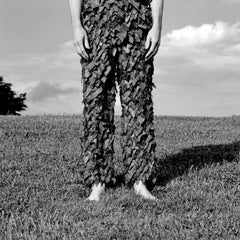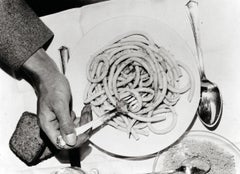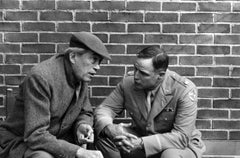Keith Sharp Black and White Photography
to
2
Overall Width
to
Overall Height
to
2
1
2
2
2
2
2
2
12
1,128
849
806
605
2
Artist: Keith Sharp
Ivy Pants, Media, PA, 2005
By Keith Sharp
Located in Hudson, NY
Each year, Robin Rice celebrates a Salon style exhibition to showcase her gallery artists and invite new ones.
With Robin’s extensive experience as a gallery curator, all Robin Rice...
Category
Early 2000s Modern Keith Sharp Black and White Photography
Materials
Silver Gelatin
Ivy Pants
By Keith Sharp
Located in Hudson, NY
Listing is for UNFRAMED print. Inquire within for framing.
Edition of 15.
CURRENT EXHIBITION – runs through September 6, 2015. Any photographs purchased during the show will b...
Category
21st Century and Contemporary Keith Sharp Black and White Photography
Materials
Silver Gelatin
Related Items
Macaroni, from Bauhaus I Portfolio
By Irene Bayer
Located in Denton, TX
Bauhaus I Portfolio
Ed. 33/70
Signed and dated in black ink on print margin.
Category
1920s Modern Keith Sharp Black and White Photography
Materials
Silver Gelatin
'Huston & Brando On Set' (Silver Gelatin Print)
Located in London, GB
'Huston & Brando On Set' 1967
Director John Huston and actor Marlon Brando on the set of 'Reflections In A Golden Eye,' 1967.
The two iconic movie stars on the set of the film in w...
Category
1960s Modern Keith Sharp Black and White Photography
Materials
Silver Gelatin
Jaybirds
By Adam Jahiel
Located in Sante Fe, NM
For years, Jahiel has been photographing the cowboys of the Great Basin–perhaps one of the most inhospitable regions of the already rugged West.
These people represent one of the l...
Category
21st Century and Contemporary Contemporary Keith Sharp Black and White Photography
Materials
Silver Gelatin
'Quiet Moment' (Limited Edition)
By Edward Feingersh
Located in London, GB
'Quiet Moment' by Ed Feingersh
Actress Marilyn Monroe relaxes on a couch in her hotel room at the Ambassador Hotel on March 24, 1955 in New York City, New York.
A beautiful and mor...
Category
1950s Modern Keith Sharp Black and White Photography
Materials
Silver Gelatin
1970s Nightclubs of Chicago South Side - Black woman striptease dancer
Located in London, GB
"I walked into a timeless place … full of supporting actors and actresses of every conceivable role," Abramson wrote in Light: On the South Side, published by Chicago's Numero Group ...
Category
1970s Contemporary Keith Sharp Black and White Photography
Materials
Glass, Wood, Photographic Film, Archival Paper, Photographic Paper, Silv...
$2,683
H 18.9 in W 14.97 in D 1.58 in
Frida at the Barbizon Plaza Hotel - Black and White Portrait, Celebrity, Woman
By Lucienne Bloch
Located in Denton, TX
Frida at the Barbizon Plaza Hotel by Lucienne Bloch is a black and white portrait of Mexican painter Frida Kahlo sitting in a chair under her self portrait hanging on the wall.
Im...
Category
1930s Modern Keith Sharp Black and White Photography
Materials
Silver Gelatin
$3,700
H 11.63 in W 8 in D 0.01 in
Kurt Hutton Fair Fun 1938 Limited Edition Silver Gelatin Fibre Print
By Kurt Hutton
Located in London, GB
Fair Fun (1938) - Silver Gelatin Fibre Print
(Photo by Kurt Hutton/Getty Images)
Two young women enjoying themselves on the 'Caterpillar' ride at Southend Fair, Essex, October 1938...
Category
1930s Modern Keith Sharp Black and White Photography
Materials
Black and White, Silver Gelatin
Street Chalk Games
By Arthur Leipzig
Located in Greenwich, CT
Framed “Chalk Games, 1950” Silver Gelatin Print photograph by Arthur Leipzig (1918-2014)
signed in margin l.r. , stamped on verso
Leipzig specialized in street photography and was ce...
Category
20th Century Keith Sharp Black and White Photography
Materials
Silver Gelatin
Stockings (1946) - Silver Gelatin Fibre Print
By Kurt Hutton
Located in London, GB
Stockings (1946) - Silver Gelatin Fibre Print
(Photo by Kurt Hutton/Picture Post/Getty Images)
1946: Three pairs of stockinged legs. Original Publication: Picture Post.
Additional...
Category
1940s Modern Keith Sharp Black and White Photography
Materials
Black and White, Silver Gelatin
'Marlon Brando & Vivien Leigh Smoking On-Set'
Located in London, GB
'Marlon Brando & Vivien Leigh Smoking On-Set'
Marlon Brando and Vivien Leigh smoking cigarettes on the set of 'A Streetcar Named Desire,' 1951....
Category
1950s Modern Keith Sharp Black and White Photography
Materials
Silver Gelatin
Swan In A Car (1936) - Silver Gelatin Fibre Print
Located in London, GB
Swan In A Car (1936) - Silver Gelatin Fibre Print
(Photo by Fox Photos/Getty Images)
6th April 1936: A tame swan named Leila is given a lift in the back of a car.
Additional Info...
Category
1930s Modern Keith Sharp Black and White Photography
Materials
Black and White, Silver Gelatin
Last Bus In London by Bert Hardy - Limited Edition silver gelatine print
By Bert Hardy
Located in London, GB
Last Bus In London by Bert Hardy
Limited Edition silver gelatine print
A couple saying goodbye on a bus in Shaftesbury Avenue in London, July 1953 .
Original Publication: Picture Post - 6576 - Known Your Piccadilly - pub. 4th July 1953
(Photo by Bert Hardy/Picture Post/Hulton Archive/Getty Images Archive London England)
Paper size 12x16 inches / 31 x 41 cm
Produced utilising the original negative
Numbered and stamped by the Getty Archive London
Limited edition to 300 only
Silver gelatine fibre based baryta paper print
Certificate of authenticity included
printed 2024
Ships securely from London.
Other sizes and Framing available on request.
Bert Hardy
Bert Hardy
Albert William Thomas Hardy (19 May 1913 – 3 July 1995) was an English documentary and press photographer known for his work published in the Picture Post magazine between 1941 and 1957.
Life and work
Born in Blackfriars, Bert Hardy rose from humble working class origins in Southwark, London. The eldest of seven children, he left school at age 14 to work for a chemist who also processed photos. His first big sale came in 1936 when he photographed King George V and Queen Mary in a passing carriage during the Silver Jubilee celebrations, and sold 200 small prints of his best view of the King. His first assignment, at age 23, was to photograph Hungarian actor Sakall at the Mayfair Hotel. Hardy freelanced for The Bicycle magazine, and bought his first small-format 35 mm Leica. He signed on with the General Photographic Agency as a Leica photographer, later founding his own freelance firm, Criterion.
General Photographic Agency
General Photographic Agency a Fleet Street, London agency, sold photos at least between 1880-1950.
Picture Post and World War II
In 1941, Hardy was recruited by the then editor Tom Hopkinson of the leading picture publication of the 1930s to the 1950s, Picture Post. Founded in 1938 and funded by publisher Edward Hulton, the magazine's first editor was Hungarian émigré Stefan Lorant (1901–97) assisted by Hopkinson, who took over as editor from 1940. The picture-centric, left-leaning and reasonably-priced publication was highly successful and circulation soon rose to over a million. Hardy's photographer colleagues included Felix H. Man (aka Hans Baumann...
Category
1950s Modern Keith Sharp Black and White Photography
Materials
Silver Gelatin
Keith Sharp black and white photography for sale on 1stDibs.
Find a wide variety of authentic Keith Sharp black and white photography available for sale on 1stDibs. You can also browse by medium to find art by Keith Sharp in silver gelatin print and more. Much of the original work by this artist or collective was created during the 21st century and contemporary and is mostly associated with the modern style. Not every interior allows for large Keith Sharp black and white photography, so small editions measuring 16 inches across are available. Customers who are interested in this artist might also find the work of Justin Creedy Smith, Bill Phelps, and John French. Keith Sharp black and white photography prices can differ depending upon medium, time period and other attributes. On 1stDibs, the price for these items starts at $1,200 and tops out at $1,250, while the average work can sell for $1,225.
Artists Similar to Keith Sharp
Questions About Keith Sharp Black and White Photography
- Where is Keith Haring from?1 Answer1stDibs ExpertMarch 22, 2022Keith Haring is originally from Kutztown, Pennsylvania, although he was born in the nearby city of Reading, Pennsylvania, on May 4, 1958. In 1978, Haring moved to New York City. He continued to live there until he died on February 16, 1990. Find a selection of Keith Haring art on 1stDibs.
- Who is Keith Haring?1 Answer1stDibs ExpertMarch 22, 2022Keith Haring was a modern American artist and activist. He began as a street artist creating graffiti-inspired works throughout New York City’s subway system and would later produce public murals in cities all over the world. Haring’s paintings, prints and murals address the universal themes of death, love and sex, as well as contemporary issues he experienced personally, like the crack-cocaine and AIDS epidemics. In 1986, Haring opened a Pop Shop in Manhattan’s Soho neighborhood to sell merchandise bearing his bold, cartoon-inspired designs. On 1stDibs, find a variety of Keith Haring art.
- 1stDibs ExpertMarch 22, 2022The Keith Haring Foundation is a philanthropic organization founded by the artist Keith Haring in 1989. Its mission is to provide funding for nonprofit organizations who offer services and programs for children or conduct research or educational initiatives related to AIDS.
- What was Keith Haring known for?1 Answer1stDibs ExpertAugust 8, 2024Keith Haring was known for his work as an artist. He began experimenting with his bold, graphic lines and cartoon-inspired figures on the walls of New York City subway stations in the early 1980s. He called these underground places his “laboratory” to develop a radical new aesthetic based on the ideology of creating truly democratic public art. Haring used paintings, prints and murals to address the universal themes of death, love and sex, as well as contemporary issues he experienced personally, like the crack-cocaine and AIDS epidemics. These works derive much of their impact from the powerful contrast between these serious subjects and the joyful, vibrant pictographic language he used to express them, full of dancing figures, babies, barking dogs, hearts and rhythmic lines, as well as references to pop culture. To make his art even more accessible, in 1986, Haring opened the Pop Shop in Soho. In a foreshadowing of today’s intermingling of art and fashion, the shop sold merchandise and novelty items featuring his imagery. Find a collection of Keith Haring art on 1stDibs.
- When was Keith Haring born?1 Answer1stDibs ExpertMarch 22, 2022Keith Haring was born on May 4, 1958, in Reading, Pennsylvania. After growing up in Kutztown, Pennsylvania, and briefly attending art school in Pittsburgh, Pennsylvania, he moved to New York City, where he made a name for himself creating street art on the subway system. Haring gained an even larger audience in the years that followed, producing public murals that were often commissioned and making art that was frequently informed by political and cultural issues. On 1stDibs, find a selection of Keith Haring art.
- 1stDibs ExpertFebruary 1, 2024Some facts about Keith Haring include that he began his career by creating street art in New York subway stations, which he referred to as his "laboratory." In 1986, Haring opened the Pop Shop in Manhattan’s Soho neighborhood and began selling merchandise and novelty items featuring imagery by himself and contemporaries like Kenny Scharf and Jean-Michel Basquiat. Also, the world's largest jigsaw puzzle features Haring's artwork and consists of 32,000 pieces. After his death, his estate formed the Keith Haring Foundation to raise awareness about AIDS and fund research into the autoimmune disease. On 1stDibs, explore a wide range of Keith Haring art.
- Where did Keith Haring live?1 Answer1stDibs ExpertMarch 22, 2022For most of his life, Keith Haring lived in New York City and died there on February 16, 1990. He grew up in Kutztown, Pennsylvania, and briefly attended an art school in Pittsburgh, Pennsylvania. After he arrived in New York in 1978, he turned the city into a gallery space, creating murals in public areas like subway stations. On 1stDibs, shop a collection of Keith Haring art.
- What inspired Keith Haring?1 Answer1stDibs ExpertMarch 22, 2022Keith Haring drew most of his inspiration from graffiti artists and got his start painting subway stations and other locations around New York City. In addition, artists such as Pierre Alechinsky, William Burroughs, Jean Dubuffet, Brion Gysin and Robert Henri influenced his work. On 1stDibs, shop a collection of Keith Haring art.
- Why is Keith Haring important?1 Answer1stDibs ExpertMarch 22, 2022Keith Haring is important primarily because his innovative work, which began as street art on the New York City subway, became widely known during the 1980s and influenced other artists working at the time. Haring was also an activist — his late-career prints and murals addressed contemporary issues he experienced personally, like the crack-cocaine and AIDS epidemics. Haring helped elevate graffiti art and was one of the first artists to begin placing his designs on merchandise sold to the general public through his Pop Shop in New York City. Shop a collection of Keith Haring art on 1stDibs.
- How do I pronounce Keith Haring?1 Answer1stDibs ExpertMarch 22, 2022To pronounce Keith Haring, say "Keeth HEH-ring." Keith Haring was born on May 4, 1958, in Reading, Pennsylvania, and grew up in nearby Kutztown, Pennsylvania. You'll find a range of Keith Haring art on 1stDibs.
- What is Keith Haring famous for?1 Answer1stDibs ExpertMarch 22, 2022Keith Haring is famous for producing bold cartoon-style art. You may see his work printed on everything from home décor to coffee mugs to fashion accessories. He gained notoriety for street art in his early days as an artist. Later, Haring’s revered paintings, prints and murals would address the universal themes of death, love and sex, as well as contemporary issues he experienced personally, like the crack-cocaine and AIDS epidemics. On 1stDibs, find a collection of Keith Haring art.
- Where did Keith Haring work?1 Answer1stDibs ExpertMarch 22, 2022In his early days as an artist, Keith Haring worked primarily in New York City, where he created murals on walls and unused advertising boards along Manhattan’s subway system. Once his work gained popularity, he traveled to produce work in Australia, Europe and elsewhere. You'll find a collection of Keith Haring art on 1stDibs.
- 1stDibs ExpertMarch 25, 2024Keith Haring's art was about a variety of subjects. His paintings, prints and murals addressed themes of death, love and sex, as well as contemporary issues, like drug use and the AIDS epidemic. His work derives much of its impact from the powerful contrast between these serious subjects and the joyful, vibrant pictographic language he used to express them. Haring’s enduring work is full of dancing figures, babies, barking dogs, hearts and rhythmic lines, as well as references to pop culture. On 1stDibs, explore a collection of Keith Haring art.
- 1stDibs ExpertApril 16, 2024Keith Haring used a variety of materials. Over the course of his career, he produced works in markers, chalk, felt-tip pens, ink and acrylic paints. For his murals, he often preferred spray paint. Interestingly, the artist rarely made sketches for even his largest works, preferring to improvise during the creation process. Find a wide range of Keith Haring art on 1stDibs.
- 1stDibs ExpertMarch 22, 2022Keith Haring became famous largely through people viewing the street art he created in subway stations and other locations in New York City. Throughout the 1980s, he was commissioned to produce art in dozens of cities all over the world and showed his works in solo and group exhibitions. A 1982 show at the Tony Shafrazi Gallery in Soho, New York City, earned rave reviews and greatly contributed to his fame. You'll find a selection of Keith Haring art on 1stDibs.
- 1stDibs ExpertMarch 22, 2022The type of art that Keith Haring primarily did was drawing. He is most often associated with the Pop art movement. Initially, Haring was inspired by graffiti artists and began experimenting with his bold, graphic lines and cartoon-inspired figures on the walls of New York City subway stations in the early 1980s. After gaining recognition for his innovative street art, Haring was commissioned to create murals in cities all over the world. Shop a range of Keith Haring art on 1stDibs.
- 1stDibs ExpertJune 6, 2024The style of Keith Haring's art is Pop art. When creating his paintings and murals, he drew inspiration from cartoons and used this playful approach to provide commentary on the issues of his time, such as the crack and AIDS epidemics, and the universal themes of death, love and sex. Since he got his start experimenting with his bold, graphic lines and figures on the walls of New York City subway stations, many people have also referred to him as a street artist. Shop a range of Keith Haring art on 1stDibs.
- 1stDibs ExpertMarch 22, 2022Keith Haring began to paint and experiment with art as a child. He first began to produce public art in 1981. His early works were chalk or paint applied to unused advertising panels found in New York City subway stations. Find a collection of Keith Haring art on 1stDibs.
- 1stDibs ExpertMarch 22, 2022You can see Keith Haring art at many museums in North America, Europe and Asia. In New York City, some of his pieces hang in the Museum of Modern Art and the Museum of the City of New York. Some of his murals remain in the city, as well. A map of all of the existing murals is available on the Keith Haring Foundation's website. Shop a collection of Keith Haring art on 1stDibs.
- 1stDibs ExpertMarch 22, 2022Keith Haring went to school briefly at the Ivy School of Art in Pittsburgh, Pennsylvania. In 1978, he moved to New York City, where he attended the School of Visual Arts. Other famous alumni from the school include Sarah Sze, James Jean and Joe Sinnott. Find a selection of Keith Haring art on 1stDibs.



